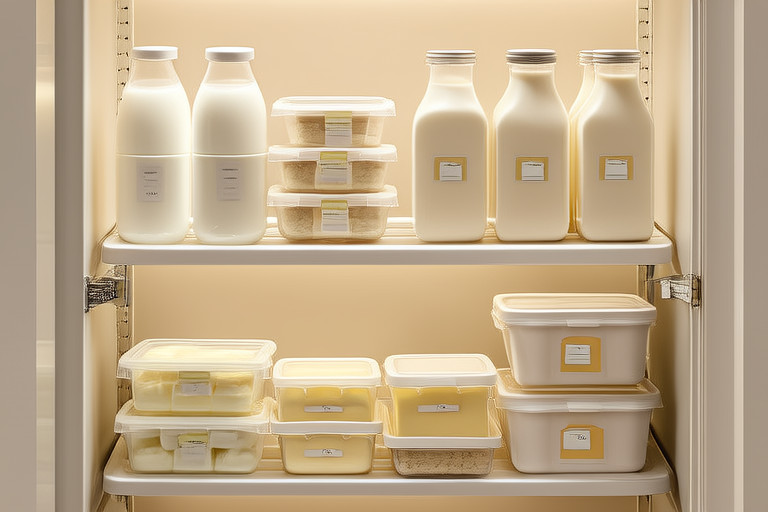The Ultimate Checklist for Storing Different Types of Dairy Products Safely
Introduction
Dairy products are staples in many households, providing essential nutrients like calcium and protein. However, improper storage can lead to spoilage, contamination, and waste. Ensuring that your dairy products stay fresh and safe is crucial not only for your health but also for your wallet. This comprehensive guide will walk you through the best practices for storing various types of dairy products safely.
Understanding the Basics of Dairy Storage
Temperature Control: The Key to Freshness
Temperature plays a pivotal role in preserving dairy products. Most dairy items should be stored at 40°F (4°C) or below to prevent bacterial growth. Invest in a refrigerator thermometer to ensure your fridge maintains the correct temperature. Keep dairy products away from the door, where temperatures fluctuate more frequently, and place them on the middle or bottom shelves.
Expiration Dates and Use-by Labels
Pay attention to expiration dates and use-by labels. These are guidelines to help you determine when a product is no longer safe to consume. However, proper storage can extend the life of dairy products beyond their labeled dates. Always check for signs of spoilage such as off odors, discoloration, or curdling before consuming.
Specific Guidelines for Common Dairy Products
Milk: Whole, Skim, and Almond Milk
Whole Milk
Whole milk has a higher fat content, which can affect its shelf life. Store it in the coldest part of your refrigerator and consume within 5-7 days after opening. If you purchase milk in plastic containers, transfer it to glass jars for better preservation.
Skim Milk
Skim milk lasts slightly longer than whole milk due to its lower fat content. It can remain fresh for up to 9 days after opening. Ensure that the container is tightly sealed to prevent air exposure, which can cause oxidation.
Almond Milk
Almond milk is a popular plant-based alternative. Once opened, it should be refrigerated and consumed within 7-10 days. Shake the carton well before each use to redistribute any settled ingredients. Store almond milk in the front of the fridge to remind you to use it promptly.
Cheese: Hard, Soft, and Cream Cheese
Hard Cheese
Hard cheeses like cheddar and parmesan can last for weeks if stored properly. Wrap them in parchment paper or wax paper, then place them in an airtight container. This prevents moisture loss and keeps the cheese from absorbing other flavors in the fridge.
Soft Cheese
Soft cheeses like brie and camembert are more perishable. Store them in their original packaging or wrap them in plastic wrap. Consume soft cheeses within 1-2 weeks after opening. For optimal freshness, store them in the cheese drawer or a covered container.
Cream Cheese
Cream cheese should be kept in its original tub with the lid tightly closed. It can last for several weeks unopened and about one week after opening. Avoid leaving cream cheese out at room temperature for extended periods.
Yogurt and Butter: Special Considerations
Yogurt
Yogurt comes in both plain and flavored varieties. Plain yogurt generally has a longer shelf life compared to flavored options, which may contain added sugars and preservatives. Store yogurt in its original container and consume it within 7-10 days after opening. Greek yogurt tends to last longer due to its thicker consistency.
Butter is a versatile dairy product that requires specific handling. Unopened sticks of butter can be stored in the refrigerator for up to two months. Once opened, it should be used within 2-3 weeks. For longer storage, consider freezing butter in airtight containers or freezer bags.
Practical Tips and Case Studies
Organizing Your Fridge
Organize your refrigerator to maximize efficiency and safety. Place dairy products on the middle or bottom shelves, away from the door. Group similar items together to make it easier to track expiration dates. Consider using clear containers or labels to keep track of what you have on hand.
Case Study: A Family’s Journey to Dairy Management
One family struggled with frequent dairy spoilage until they implemented a structured storage system. By following these tips, they reduced waste and enjoyed fresher dairy products. They now rotate items regularly, ensuring older products are used first. This simple change saved them money and minimized food waste.
Summary and Actionable Steps
In summary, proper storage of dairy products involves maintaining the right temperature, paying attention to expiration dates, and understanding the unique needs of different types of dairy. Here’s what you can do:
- Check Refrigerator Temperature: Ensure your fridge is set to 40°F (4°C).
- Organize Dairy Items: Place dairy products on the middle or bottom shelves.
- Use Proper Containers: Use airtight containers or original packaging to protect dairy items.
- Monitor Expiration Dates: Regularly check and use older products first.
By following these steps, you can enjoy fresh, safe dairy products while minimizing waste. Implement these strategies today to enhance your kitchen management and overall food safety.
